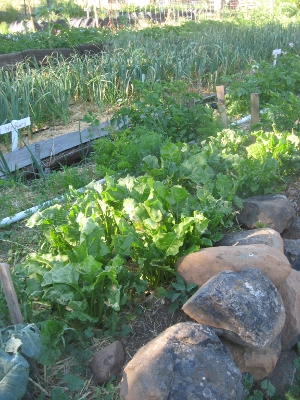Making Beet SugarNovember 22, 2011 Lindsay: In our ongoing efforts to close the loop and provide for ourselves from this land base, we are experimenting with some less than traditional home-garden crops. For example, one of the experimental crops this season was sugar beets. Sugar beets are a sister cultivar of the more popularly used red beet root and Swiss chard, which are all technically considered the same species, Beta vulgaris. In comparison to beets, sugar beets have a higher concentration of sucrose, between 15-20% by dry weight. About 35% of world sugar production is from sugar beets. GROWING SUGAR BEETS Beets grow well here on this plateau, and so too, apparently, do sugar beets. The sugar beets survived the summer heat fine, though this summer was milder than the average, and required minimal water. In theory, sugar beets can tap water down to six feet, which may account for their drought tolerance here.The sugar beets, like most other crops, required a good weeding in the spring, and then a thinning, but beyond that, they required little labor.
The primary problem came in the early fall, when ground squirrels decided to burrow under a portion of the sugar beets, eating their way through the bed. The next morning, I found the bottom half of several beets gone, while the top half, attached to the leafy, top still remained. EXTRACTING SUGAR Soon after the squirrels discovered the sugar beet patch, I harvested 16 lbs of beet root from the 2x5 section. Then came the part of actually trying to make sugar. I made two batches, which varied in cooking length, and ultimately consistency.
First, I cleaned the beet roots and then cut them into chunks of a size that could then go into a food processor. The food processor then shredded the chunks.(The smaller the beet size, the more surface area is exposed and the more sucrose can dissolve into the water). I added the shredded beet to a large pot, adding just enough water to cover the beets. Then I cooked it at a low boil for about one hour. After cooking the beets in water, I poured out the now sugary liquid (SAVING IT!) and pressed as much moisture as I could out of the rest of the beet pulp. I combined the liquids, which at this point are a brownish or dark grey color, and cooked the liquid for several hours at a low temperature until enough water evaporated for the liquid to thicken. As I mentioned above, I did two batches. The first batch cooked long enough to create a thick syrup--maple syrup-like in consistency. I cooked the second batch longer, to the point where it had a gooey texture. I have put both in jars to see what happens. So far, the syrup has maintained the same texture and consistency. The second batch appears, while overall of a thick, spreadable consistency, to be crystallizing. For when I sample it, I can detect the texture of sugar crystals. Sugar beet pulp (also referred to as sugar beet cossettes) is created in volume from sugar extraction from the beets. I have used the pulp to make a quick bread, similar to the way I would use apple or zucchini, and moderately reduced the amount of sugar added. The animals also seem to quite enjoy the beet pulp. TASTE The taste of the sugar extractions is certainly unique. The color is dark, and the flavor complex, minerally, and very sweet. More than anything else, the taste reminds me of unprocessed sugar cane sugar syrup and crystallized sugar, which also has a dark color, and complex, minerally flavor. The flavor is more mild than molasses, which makes sense as molasses is the liquid that remains after sugar beets have been processed to form "white sugar", and contains too many of what the industry calls "impurities" to be further processed into commercial sugar.
The beet sugar syrup which I made could be used as a sweetener for drinks, baking or poured over deserts. The thicker sugar extraction, if not fully crystallized, spreads well and could be used on toast, similar to honey or of course dissolved for uses in baking, similar to molasses or honey. THE NUMBERS The 16 pounds of sugar beets, grown in 10sq feet of garden space, created about 2 cups of the sugar extractions. So clearly, any attempt at supplying ourselves with even a modest amount of sugar (other than honey) would require significant growing space. Based on the numbers from this year's crop, the production of 100 cups of sugar would require at least 500 square feet of growing space. To provide a comparison, we grow our year's supply of potatoes (and we don't eat that many potatoes) in about 360 square feet. While producing sugar from sugar beets may not be the most efficient use of growing space, a sweet treat goes a long way towards boosting morale. And while long term, honey may more likely be our best bet in terms of producing sweetness, we need to increase our nectar production, (primarily in the form of locust trees but a whole suite of plants are necessary to provide a season long supply of nectar) to be able to support the hives. And as with most things, using a diversity of techniques to meet our needs increases our security and resilience. Plus, making your own sugar, at least at the experimental scale, is rather fun. |


